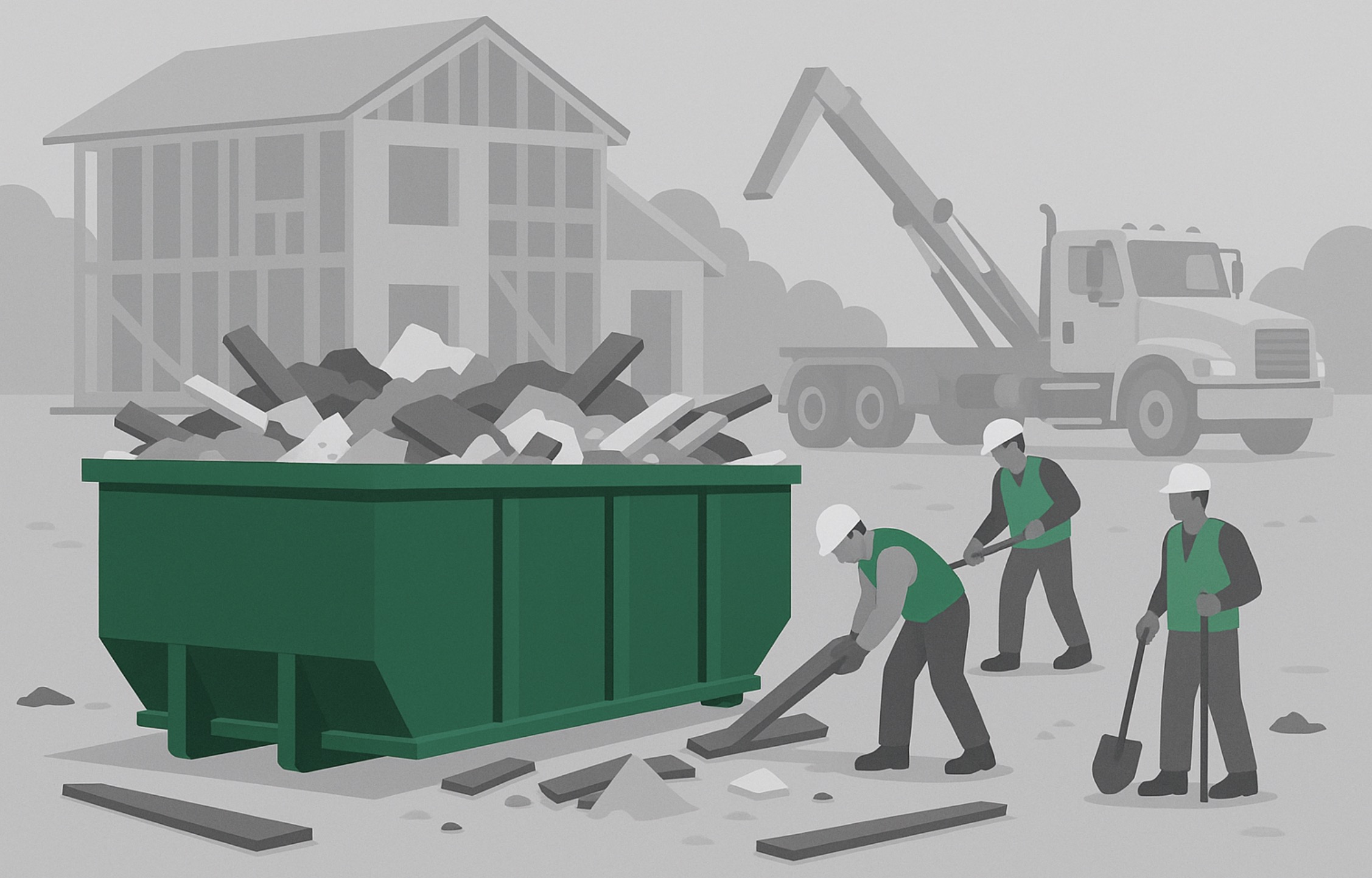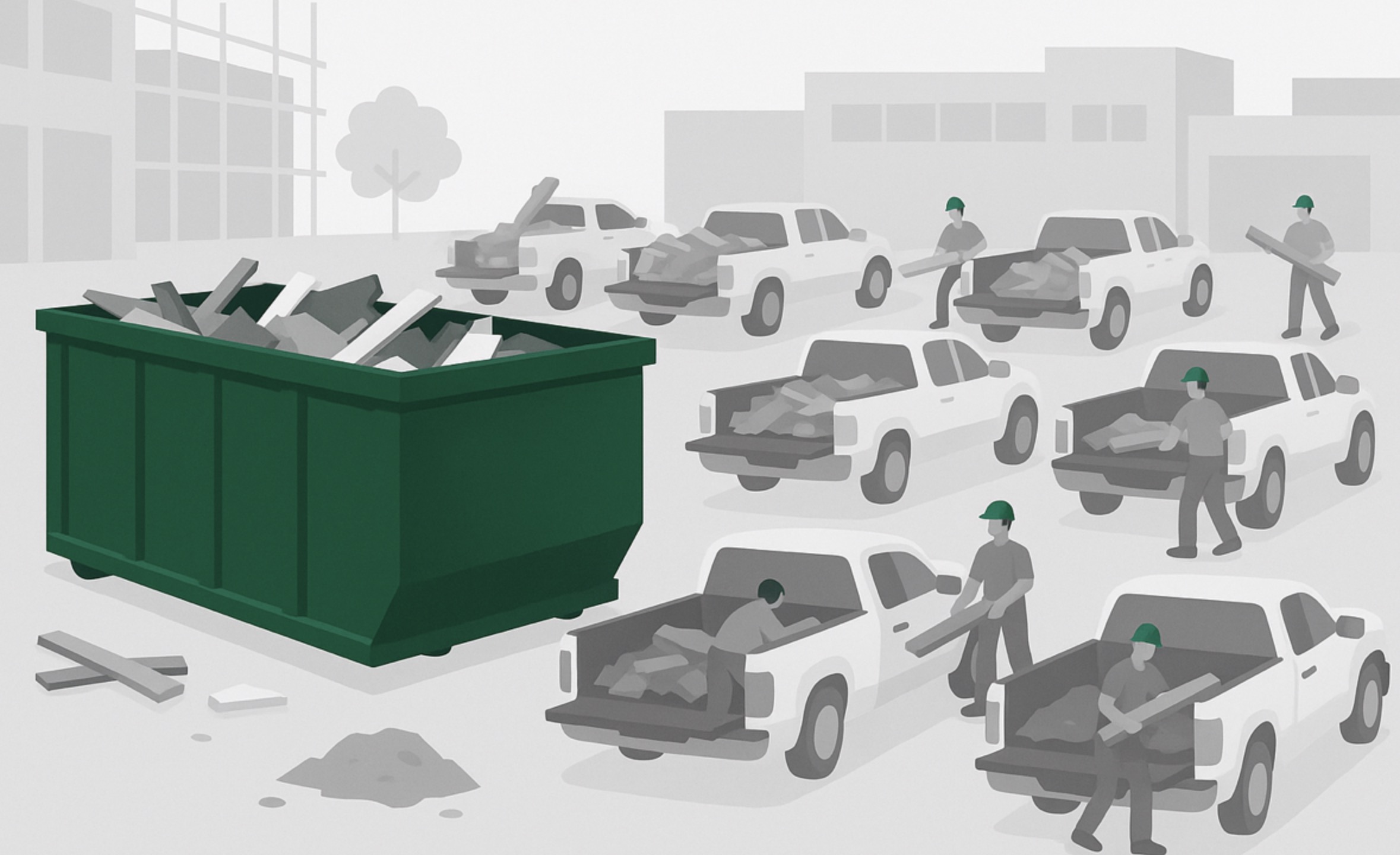Find construction dumpster rentals near you.
Enter your ZIP code to get started.
Page Contents
Helpful Tools
Construction Dumpster Rental Guide
Construction debris can accumulate fast on any job site without proper handling. Scattered debris can create obstacles that slow down work and pose safety risks. Most contractors end up making multiple trips to the landfill or letting materials pile up until they become unmanageable. Construction dumpster rentals can solve this by providing a single, centralized location for your project's waste. It keeps your construction site clear and your team productive throughout the project.
What Are Construction Dumpsters and Why Do You Need One?
Large roll-off construction dumpster rentals are built to hold between 10 and 40 cubic yards of material and support 1-10 tons per load. The steel containers arrive on a specialized roll-off truck, are set safely on level ground, and are removed when full—eliminating job-site clutter and multiple runs to the dump.

Federal and state regulations require debris from demolition, renovation, or new construction to be stored in proper containers, segregated when necessary, and transported to approved facilities. Using a purpose-built dumpster simplifies compliance with OSHA housekeeping standards that mandate continuous removal of scrap lumber, waste, and rubbish as work progresses.
Types of Waste Accepted in Construction Dumpsters
- • Structural debris such as lumber, trusses, and engineered wood
- • Masonry, concrete, asphalt, and brick
- • Metals, drywall, roofing shingles, and siding
- • Non-hazardous packaging, cardboard, and plastics
Prohibited items include paint, solvents, asbestos, batteries, and other hazardous materials that must follow specialty disposal channels.
Common Uses: New Builds, Renovations, Demolitions
Whether clearing a 2,000-square-foot tear-down, roofing 40 squares, or fitting out a retail shell, roll-off dumpsters keep debris contained and loading paths clear, reducing trip hazards and improving worker efficiency.
Choosing the Right Size: Types of Construction Dumpsters Available
Selecting the correct dumpster size can help prevent overage fees and downtime while ensuring you're maximizing your dumpster's capacity.
Pro Tip: If you're unsure about the size you need, it's better to go a little bigger than too small. You can always fill the dumpster with less material if it's too big.
| Dumpster Size | Dimensions (L × W × H) | Capacity (Cubic Yards) | Ideal For | Weight Limit (Tons) |
|---|---|---|---|---|
| 10-Yard | 10' × 8' × 4.5' | 10 | Kitchen renovations, bathroom remodels, small construction | 2–3 |
| 15-Yard | 15' × 8' × 4' | 15 | Medium renovation projects, small business cleanouts | 2–3 |
| 20-Yard | 20' × 8' × 4.5' | 20 | Home renovations, construction projects, roofing projects | 3 |
| 30-Yard | 22' × 8' × 6' | 30 | New construction, major renovations, demolition projects | 5 |
| 40-Yard | 22-24' × 8' × 7.5' | 40 | Industrial projects, major construction, large demolition | 6–10 |
| Lowboy | 18' × 8' × 2.5' | 10 | Concrete removal, dirt & soil disposal, brick & masonry | 10 |
The weight limit is as important as capacity; dense debris such as concrete can hit the tonnage cap while filling only half the volume, making accurate material estimates essential.
Benefits of Using Construction Dumpsters for Your Project
Time Savings
One drop-off and one pickup replace dozens of truckloads, keeping crews focused on core tasks.
Cost Efficiency
Flat-rate pricing bundles delivery, disposal, and tonnage, often beating the expense of multiple trips to the landfill.
Safety
Unsecured debris is one of the leading causes of slips, trips, and struck-by incidents; contained waste reduces risk.
Environmental Compliance
Reputable haulers sort and divert recyclable C&D materials, supporting EPA goals to cut landfill volume and greenhouse emissions.
Cost Savings vs. DIY Hauling
A 30-yard dumpster holding up to 5 tons can eliminate 12–14 pickup-truck runs, slashing fuel costs, landfill tipping fees, and labor hours.

Compliance with Local Regulations
If the container rests on a public street, most municipalities require an encroachment or "A" permit that covers up to seven days of placement. Reputable providers handle paperwork or guide you through the process to avoid violations.
Step-by-Step Guide: How to Rent a Construction Dumpster
Assess Your Debris
Estimate cubic yards and weight by project scope (e.g., 25 squares of shingles ≈ 3 tons).
Request a Quote
Provide size, zip code, and rental duration; transparent haulers list delivery, pickup, and weight allotments upfront.
Schedule Delivery
Clear 60 feet of straight access and 23 feet of vertical clearance; place plywood under wheels on softer surfaces to prevent damage.
Load Evenly
Walk heavy items through the swing door, distribute weight side-to-side, and keep debris below the fill line to avoid dig-out fees.
Call for Pickup
Most providers include seven-to-ten-day rentals, with low per-day extensions if needed.
Preparing Your Site for Delivery
Choose level ground away from overhead wires and mark the area with cones or caution tape to keep vehicles clear.
What to Expect During Pickup
Drivers tarp the load, weigh in at the nearest facility, and email a disposal ticket so you can document tonnage for LEED or municipal reporting.
Construction Dumpster Rental Costs: What to Expect
National averages range from $300 to $800 depending on size, weight, rental length, and local disposal fees.
Urban markets with higher landfill rates trend toward the top of the range, while rural areas skew lower.
Primary Cost Drivers
Size & Weight – Larger bins not only cost more to rent but also carry higher included tonnage.
Location – Fuel and regional dump fees vary widely; coastal metros can see tipping fees above $100 per ton, versus $35–$50 in many inland counties.
Rental Duration – Standard terms are 7–10 days; daily extensions average $10–$25.
Debris Type – Inert material (concrete, asphalt) sometimes qualifies for discounted "clean load" rates, while mixed debris follows standard MSW pricing.
For an exact quote, enter your zip code, container size, and estimated rental days in the instant calculator above, then lock in delivery with one click.
Frequently Asked Questions About Construction Dumpsters
What size construction dumpster do I need?
Match dumpster volume to your debris: 10-yard for a bathroom gut, 20-yard for single-room remodels, 30- or 40-yard for full-house builds.
Can I put concrete in a construction dumpster?
Yes, but limit loads to 10- or 20-yard containers and never exceed the posted tonnage; concrete weighs roughly 4,000 lb per cubic yard.
How long can I keep a rented dumpster?
Most rentals include up to 10 days with flexible renewals at a daily rate; arrange swaps for long-term projects.
Do I need a permit?
If the bin sits on private property, no. Street or sidewalk placement usually requires a temporary right-of-way permit from your local public works office.
What items are prohibited?
Hazardous wastes such as oils, paints, pesticides, asbestos, tires, and electronics must be routed through specialized programs, not dumpsters.